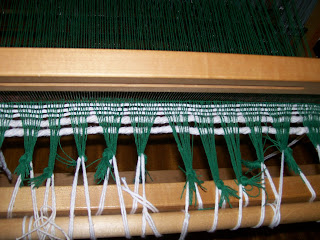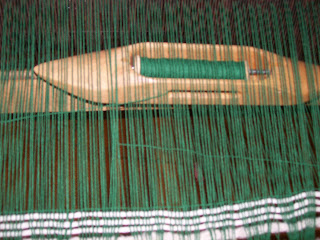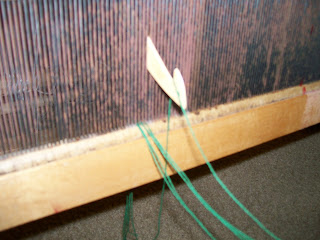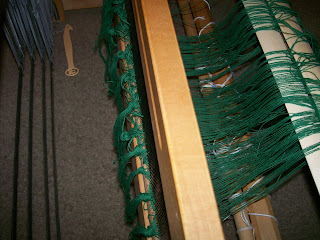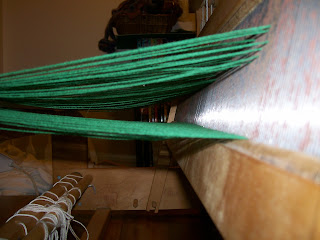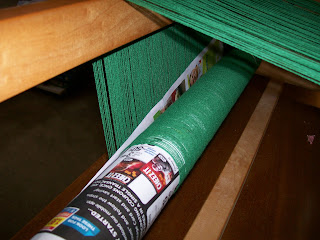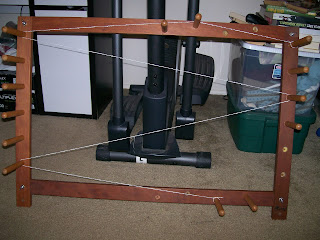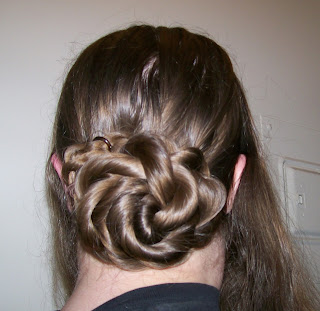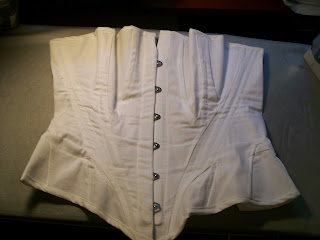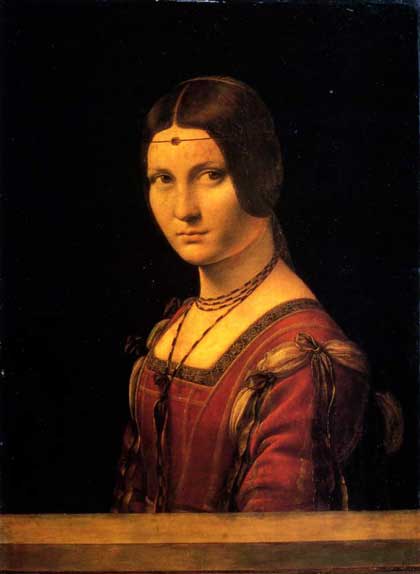I have focused on terms found in magazine and book descriptions of hairstyles in the 1850s and early/mid 1860s. Some earlier and later expressions are included, with sources dating from 1830-1881.
A great many borrowings from French are found, and some publications favor either French or English terms; others use both. Following period conventions, I've italicized words and expressions given in French, but not ones which seem to have passed into English usage. A few regional dialect or slang expressions related to hair are also included.
This is an on-going project, so inquiries, suggestions, and critiques are welcome; I will continue adding entries, improving citations, etc. as I find more information.
Accroche-coeurs: The French name for a "spit curl". (25)
Aureoule (aureole): A ring of light around the head, used in some ecclesiastical images to denote holiness (a halo); a decoration worn over the head in a similar manner.
Example:
"Aureoles of small rosettes made of narrow black ribbon velvet, edged with white, are also much worn with nets made of the same ribbon." (20)
Bandeau(x): French for "headband(s)" or "band(s)." May refer to way of arranging the hair, or an ornament worn on it (a band or fillet).

Bandeau bouffant: A bandeau made over teased hair for additional volume.
Band: A plain band is a relatively smooth arrangement of the hair along the scalp, or over rats; may also be made using waved hair. See "bandeau". Also, a decoration laid on flat, such a ribbon or piece of lace, or a length of braided hair brought over or across the head (similar to a "coronet").
 |
| An ornamental band, worn badly. (19) |
 |
"The hair is arranged in waved bands,
short and puffed." Harper's, 1851 |
Bandelets: A decoration for the hair, consisting of ribbons, velvet, or gilt bands passed over the head. The ribbons are decorated with beads, or sometimes sequins. (20)
Bandoline: A "soft" pomade used for styling the hair and keeping it neat. Described as "gummy" and "liquid", in contrast to harder wax-based products. (23) Apparently going out of fashion in 1856. (13) Two
1854 receipts derive it from quince seeds extracted with rose water, or from gum tragacanth mixed with rosewater.
Barb/barbe: A piece of lace often worn streaming down from a head-dress, cap, or bonnet; a
lappet or "pinner" on a head-dress.
Barkit: "Dirt hardened on hair, and hence forming a kind of bark", English provincial term. [I hope this is describing animal hair and not human!] (18)
Basket Plait: A four-strand plait, in which three strands are braided as usual with a fourth going straight through the center; I've found written references to this plait are in the 1850s or 1880s, but not the 1860s.
Demonstration here. (5, 24)
Barnet Fair: British rhyming slang expression for "hair". (25)
Braid: See "plait".
Bob: To cut the hair short; an American expression. (4)
Bouquet: A cluster of flowers; may describe flowers worn in the hair. (12)
Bow-catcher ("beau catcher") British slang expression for a "spit curl". (25)
Bow: A style incorporating two side-by-side waterfalls, resembling two loops of a bow (see "waterfall" for illustration). (9)
Broches Frisettes: French, "(little) ringlet pins". See "curling pin."
Cable Twist/Cable Plait: A round plait of three strands; it is made by bringing the left strand around the center strand, then the right strand around the center.
Tutorial here.. (5, 24)
Cache-Peignes: French, literally "cover combs". A hair ornament worn over the chignon. Named as an alternative to wreaths for formal hairstyles. (3)
 |
Cache-peigne worn with evening dress
and matching sash.
Godey's, February 1861 |
Calflick: Hair which lies in a different direction from the rest of the hair; a Cravenshire (English, Northumbrian) provincial usage. (18)
Cat: A
frizette worn on the top of the head. (15)
Cataract: A
frizette used in a "waterfall" worn at the back of the head. (15)
Caul: The hair-covering back portion of a
cap (32); potentially also a decorative crown-like accessory. The
term appears in fashion descriptions of caps in the 1840s, and
describing a blue velvet head-dress in 1858. (33) Other references are
historic or
ethnographic.
Chain Plait: See basket plait. (5)
Chaplet (less often "
Chapelet"):
Also called a "drooping wreath." Recommended for formal headdresses for tall women (in the
Fashionable Dancer's Casket, 1856).
Chevelure: French for "hair". (30)
Chignon: A general term for hair arranged in a mass at the back of the head; coils, knots, twists, and waterfalls may all be considered chignons. Borrowed from the French, meaning either "the 'back hair' of ladies" (26), or "the nape of the neck; the back part of the hair turned up." (30).
Circassian Braid: A fancy braid that I've found mentioned exactly once, in an 1855 article in
Harper's New Monthly Magazine.
 |
Grecian braid/plait (top),
basket plait (background),
"Circassian braid" across the back. |
Coiffure: A hairstyle (14), especially a fancy or involved one; a headdress (13,14); occasionally used as a verb meaning "to dress one's hair". (3) From the French term for a head-dress (30).
Coiffure de bal: A hairstyle to wear at a ball.
Coil: Hair twisted and wrapped around itself into a circular shape; a bun (I have not found "bun" used to describe hair in a period source).
 |
| A coil (9) |
Comb: An ornament worn at the back or side of the hair, held in place with 'teeth' (
examples here); plain tortoiseshell combs may also be worn to add volume to the hair; also, a tool for untangling the hair, available in fine and coarse varieties. (15)
Couronne: French for crown/crowned; it is mentioned in
Arthur's Home Magazine (1856) and appears to be a braid passed over the head as a coronet.
Coronet: A crown, circlet or diadem; a similarly shaped ornament of ribbon, velvet, or even
feathers, or a braid of hair worn across the head in a like manner. For the latter, see also "band". (20)
County Crop/ County Prison Crop: British slang for a short prison haircut, said to resemble an inverted basin. (25)
Cow-lick ("Newgate Knocker" or "Cobbler's Knot"): British slang for a large curl, none too clean, worn by of the ear, associated with tramps, thieves, etc. (25) Also a provincial term from Norfolk and Suffolk describing a twisted area of hair on a calf's forehead. (18)
Croppie: British slang for one who has short "cropped" hair, presumably from a recent stint in prison (see "County Crop"). (25)
Curl: A twist of hair, treated as synonymous with "ringlet". "Curl" is also, apparently, the name of a disease affecting potato plants. (29)
 |
| Graham's Magazine, 1856 (13) |
Curl Clasp: Item sold by
Godey's in the 1860s, for curling the air. (16) Described in a
January 1859 article, these clasps function like modern curlers: hair is wound around the clasp, which is fastened and left in place for several hours to set the curl. The clasps may be heated prior to use.
Curl-paper/ curl paper: Pieces of paper wound through and around the hair to produce curls; they must be employed for
hours before the curls are desired. These may be made from
newsprint, and in whatever form, are depicted as unlovely. Soft paper or silk are
recommended over hard paper. The method to use them is described in
Female Beauty.
Curlingirons/ Curling-irons/ Curlingtongs: Hot implements used to curl the hair. Curling irons. (6)
Curling Pin: Illustrated in Godey's in January 1859, these pins help hold curls in place during wear. Possibly also used to form the curl (see "curl clasp"). See here for more information.
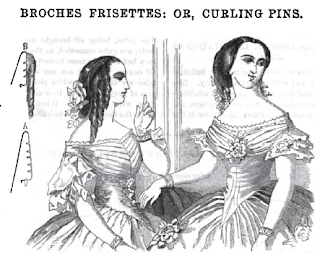 |
Illustration of "Curling Pins" to keep long curls and and puffs net.
Godey's 1859 |
Curling Fluid: Product with supposedly curls the hair "immediately", without needing to use hot curling-irons or wait for several hours in curl-papers. (
1858 advertisement here)
Crimpers: Advertised by
Godey's in the 1860s; they come in boxes of 12, in different sizes. (16) These appear to be for waving/crimping the hair (see below), though an 1854 dictionary definition suggests that crimping and curling are the same thing (29); a 1869 description of "boiled" hair, however, uses "crimp" to indicate the waves produced by braiding, which is closer to the modern definition of "crimp", ie, causing the hair to zig-zag. (21) An article in
Godey's (page 167, August 1859) shows how to wind damp hair around a U-shaped crimper so that it will dry overnight to produced waves. Six crimpers are recommended per side of head, with longer ones used up front (thus, the box of twelve in different sizes).
Crimping Iron: "An iron for curling hair". (11)
Dander: Dandruff or scurf. An "Americanism". (4)
Demi-toilette (or
"half costume" or "undress"): Informal attire or style for wear during the day or at home. Less lavish that "full dress", often with simpler hair styles, and little or no jewelry.
Demi-wreath: A half-wreath, which only encircles part of the head.
Diadem: A style of crown or circlet, typically of precious material.
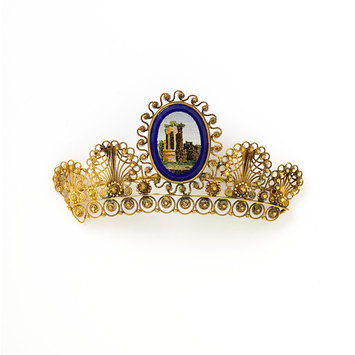 |
| Italian Micro-mosaic diadem, c. 1840 (VAM) |
Dress: To style the hair; a description of the formality/occasion of one's clothes and accessories (see "full dress", "undress", etc.).
Elf-locks: "Hair supposed to be entangled by an elf"; Cravenshire (British, Northumbian) provincial term. (18)
Fanny Blair: Rhyming slang for "hair". British. (25)
Féronnière: A band worn across the forehead (see picture).
Godey's mentions them being "very fashionable" in 1840, but does not describe them. (15) The term is only used a few times during the 1840s, and I've not found it used in the '50s or '60s. Possibly named for the ornament appearing in Leonardo Da Vinci's
"La Belle Ferroniere" (mis-attributed to Titian in this
1834 article). The name is apparently derived from a French term for an iron-worker or maker of horse-shoes. See also "band".
 |
""Head dressed with roses, and a Bird of Paradise.
Gold féronnière..." Godey's 1842 |
Fillet: See "bandelet".
Fix the hair: An
expression in New England and Upper Canada meaning "to dress the hair." (4)
Flick-Tooth-Comb: A coarse or wide-tooth comb for untangling the hair, in Somerset (British) dialect. (18)
Folds: An option for arranging front hair in the 1850s. (5)
French Twist: Apparently the same as a modern "French twist"; shows up in this 1855
Harper's coiffure, along with several fancy braids. From the frequency of references, the french twist was fairly ubiquitous for back hair
1854-56 (1); it is "old fashioned" but "again becoming quite popular" in
1865, according to Peterson's (20), returning again in
1872 and
1878.
Instructions here.
 |
French Twist surmounted by Grecian Plaits;
also contains cable twists, bandeau, and seven-plaits.
Harper's, 1855 |
Friz/ Frizle/ Frizzle: To curl the hair. (6)
Frizette: A pad of hair (typically brushings, which may be curled) or silk which is placed underneath the hair to add volume and shape. Also used to form the base for pin-in chignons, waterfalls, etc. See also "rat".
Front/ False Front: An item made by a hair-dresser, presumable an arrangement of false hair worn at the front of the head or above the face. (5, 9)
Frouzy: Describes a person will messy or unkempt hair and clothes, in Norfolk (English) dialect. (18)
Full Dress/ Full Toilet: "Dressed for company." (29) Usage indicates formal wear, particularly for fancy dinners and evening entertainments, including balls. Typically entails more elaborate richly ornamented hairstyles than for day-wear; clothing and jewelry are also fancier.
Gum: A sticky substance, used keep the hair neat, and reportedly going out of fashion in 1856. (13) See also "bandoline".
Grecian: A type of "waterfall". (2)
Grecian Plait: A popular decorative braid/plait in 1850s and 60s coiffures, where it is often placed prominently across or over the head. The Grecian plait is very similar to a modern fishtail braid: the hair is divided into two bunches, and a small segment at the outside of one bunch is moved to the inside of the second; this is then repeated on the opposite side. Pictures of the process
are available here. (5, 24)
Greek Head-Dress: See "bandelet".
Hair-pincers: A tool for curling the hair, c. 1840 (See Curlingiron). (15)
Half Peruke: See "peruke".
Harl: Hair or thread, a provincial English term from Northumbria. (18)
Head Dress/
Head-dress : A general term for involved hair decorations, such as wreaths, caps, bands, etc; the dressed hair itself: synonymous with some uses of "coiffure". (9)
For example:
"A charming coiffure was composed of a wreath of flowers, almost round, and very full, over which was placed a barbe of point lace, the long ends falling over the neck. The same head-dress may be made of geraniums and black lace, or cornflowers and English lace; also with velvet ribbons instead of the flowers." (3)
Hen-caul: A net or cap used to confine the hair, Northumbrian (English) provincial term. (18)
Huer/Hure: English provincial term for "hair," from Northumbria. (18)
La Chinoise: A braid/torsade (rope) or row of curls worn just above the forehead (20). See also coronet.
 |
Peterson's, May 1865; in the October issue, the editor opines that
mixing "both plait and tiny curls...causes a superfluidity of ornament". |
Lappets: Streamers of lace or ribbon on a cap or
in the hair, typically placed on either side of the head near the ears. Also, a figured cloth with a woven design resembling embroidery (
1863).
Lock, Locks: A segment or section of hair, typically referring to hair that is unbraided and flowing, especially hair worn loose at the temple and cheek. (8) A small piece of hair kept for sentimental reasons, such as in a locket. (11)
Loop: A free hanging section of hair or ribbon, with both ends confined.
 |
Opera Coiffure: "The front hair is turned back from the
centre of the forehead and forms full bandeaux on each side.
Two rouleaux of hair pass across the upper part of the head
and a plait is disposed in a loop below each ear.
A bouquet of flowers ornaments the back of the head. (12) |
Lovelock: An archaic term, see "spit curl". (25)
Kidney: A hairstyle worn by students at Cambridge, British provincial term. (18)
Kiss-Curl: British slang expressions for a "spit curl". (25)
Knot: Popular period term for hair done-up at the back of the head; in some contexts it seems to particularly denote a "bun", either plain or braided. See also "twist".
 |
Victoria Penny: "The queen's head to left,
with a bandeau or fillet bound twice around it;
the hair gathered up in a knot behind." (31) |
Macaroon Tresses: A popular style for little girls in London and Paris in 1856, according to
Graham's Magazine. (13) Appears to be a form of plait/braid, worn long. Possibly related to the obsolete term
"macaroon/macaroni" to indicate a fop or dandy, reputed to wear voluminous false hair.
 |
Macaroon Tresses with ribbons;
front hair in combs, covered with rosettes. |
Mouse: A little
frizette, smaller than a "rat". (15)
Mouldy: British street slang for a person with grey or powdered hair. (25)
Net: A covering for the back hair, typically netted in either colored silk (as a decorative article) or in very fine silk or hair in a shade matching the wearer's hair (an invisible net). The latter can be a utilitarian article meant to keep to confine the hair and maintain a neat appearance; it is also mentioned in
Peterson's October 1865 that silk or hair "invisible" nets are in vogue for evening wear, as they don't cover up the hair itself (page 294). Decorative "nets" of woven ribbon are also possible. Nets may be ornamented with beads, tassels, ribbons, etc. Anna Worden Bauersmith has a more detail investigation of mid-19th century hair nets
here.
 |
| "Black velvet net for the hair, with four heavy gold tassels." Godey's, 1861 |
Negligee: French for
"undress, loose or neglient dress". See "demi-toilette".
Papillotes: See curl-paper.
Peruke: A voluminous wig, worn by gentlemen in the 17th and 18th centuries. Most period references are to
historic practices, though one names "perukes" among the items made by in-house by hair-dressers. (5) The "half peruke" featured in
Harper's in 1867 appears to be a ready-made back half of a
coiffure. (17)
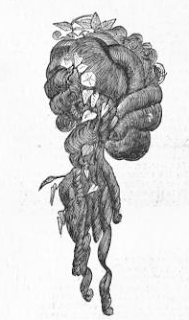 |
| Half peruke. 1867 (17) |
Plait: The more common term for a braid, when referring to hair. The basic version comprises three strands of hair (7), and is executed by moving the right-most strand into the center, then the left strand into the center, and repeating until the desired length is reached. In the mid/late 1850s, there's a fashion for "plaits of five, seven, then, and even more strands, woven more or less openly". (5) "A plait" may also refer to a detached section of hair which has been plaited or braided, and which is pinned on the head as part of the
coiffure. (9)
Pomade: A scented oil or grease. See pomatum/bandoline.
Pomatum: A hair-dressing aid comprised of perfumed "lard or suet, or a mixture of wax, spermaceti, and oil". More solid than bandoline. (23)
Point: A method of trimming the hair to taper the ends of curls or to remove split ends; the ends of the hair themselves. (27)
Pow: To cut the hair, in Northumbrian (English) dialect. (18)
Puff: Similar to a band/bandeau, but with the hair wound around multiple separate frizettes/rats/mice to produce a three-dimensional effect. The hair may be smoothed or waved. Puffs may be made from one's own hair, or from false hair. (9)
 |
| Front and back puffs (9) |
Rat: A
frizette, particularly one worn at the sides of the head, though it also seems to be a general term. (15)
Ready: To comb the hair in preparation for dressing it; British provincialism from Northumbria. (18)
Ready-comb: "A wide-tooth comb"; British provincialism from Northumbria. (18)
Roll: Hair which has been smoothed around into a tube-shape, typically used for the side hair. May also be made a separate piece and pinned in place. (2)
 |
| Curls arranged to look like rolls. (14) |
Roping: Twisting two strands of hair around each other, in a manner resembling a rope. (1)
Tutorial here. See also "torsade".
Rosette: A rose-shaped (round, spiraling out from the center) arrangement or hair, ribbon, etc.
Rouleau: A french term for "roller." (29)
Scroll: An arrangement of the back hair, rolled and pinned into a sideways S shape. Appeared in fashion magazines in 1862-3.
 |
"The hair is in a double roll in front,
with a curl falling behind each ear.
The back hair is tightly rolled and
formed into a scroll, and kept in
place by two fancy pins." (14) |
Scurf: Scale-y skin flecks which accumulate at the root of the hair and can be removed by brushing or washing; dandruff. (28, 10)
Slick: Sleek, to make the hair sleek by combing it. English provincial term, the verb form being attributed more specifically to East Sussex. (4, 18)
Spit Curl: A curl of hair on the forehead, "probably...plastered into shape by the saliva". American term (see "bow-catcher" for other synonyms). (4, 25)
Strand: A single hair, in Southern US terminology. (4) Also used to refer to the number of sections in a plait or braid, ie, a 5-strand braid. (5) In braiding cut hair for jewelry, a strand is a group hairs of a set number, ie "take sixteen strands of about twenty hairs each". (22)
Suit of hair: Mid- or Southern US expression, equivalent to "a head of hair". (4)
Switch: A length of cut hair, stitched or bound together at one end, which may be incorporated into a
coiffure. (9)
Tail: An item made by a hair-dresser; presumably false hair worn at the back of the head. (5)
Three Fold Twist: An alternative to three-plait in some styles; research is on-going, but I suspect this is a three-strand version of a "rope". (
1870s?)
Three-Plait: A basic three-strand plait or braid. (7)
Toatt: A tuft, whether of hair or of another substance; English provincialism from Lancashire. (18)
Torsade: Appears to have two or more meanings. One is a length of hair or ribbon which appears to be "roped"; ribbon thus arranged appears on dresses and headdresses (
Godey's 1859). There's also an 1866 reference in
Godey's which describes a braided waterfall: "Another favorite mode of arranging the hair is a torsade, or species of waterfall, formed of four heavy plaits united and caught up with a fancy comb."
 |
"The velvet torsade which crosses the hair
is relieved by lappets of the same..."
Godey's February, 1861 (16) |
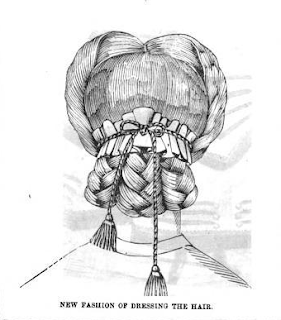 |
Though not named, this style from Peterson's (1865),
resembles the description of a "torsade"
in Godey's the following year. |
Toilette/Toilet: One's appearance; to "make one's toilette" is to clean and dress oneself, including arranging the hair. (24) From the French "toilette", meaning "a dressing table; the act of dressing". (29)
Tocque: Headdresses that "have lost nothing of their vogue" in 1840, according to
Godey's. (15) Apparently a French term for a hat or cap, particularly a style of Breton origin (
according to Wikipedia). There may also be a connection to the
Waverley novels of Sir Walter Scott (published between 1814 and 1831) which contain a mention of "vagabonds' tocques and turbands."
Tress/Tresses: Poetic term for a lock/section of hair worn down; in the plural, all of one's hair. Technically, tresses are braided while locks are unbraided sections of hair, but in context, the distinction is not always maintained. (8, 13) Loose sections of supplemental hair are described as tresses in 1867 (though they are intended to end up braided in with the wearer's own hair). (17)
 |
False tresses for lengthening the hair;
the crepe portions are braided into the
wearer's hair. 1867. (17) |
Twist: Interchangeable with "knot" to describe back hair; seems comparable to the modern "bun".
Undress: See "demi-toilette."
Ringlet: One 1840 source mentions ringlets as "cork-screw shaped" curls and gives advice for using pins to keep them neat. An
1846 dictionary uses both "ringlet" and "wave" as synonyms for "curl". I've found no 1850s/60s styling references calling for ringlets; instead, "ringlet" seems to be used to describe
single curls or locks of hair kept for
sentimental reasons, especially in poems. (15)
Rosette: A decoration resembling a rose; often made by gathering ribbon, lace, stripes of fabric, etc. into a round shape. Used on clothes, shoes, and some hair ornaments. Sometimes used as a separate accessory, which may also be called a cockade or badge.
Waterfall: A style of putting up the back hair, in which smooth hair appears to spill over a form. It's first mentioned in Godey's in 1863 (14), and becomes ubiquitous around 1865-66, apparently supplanting the twisted or coiled chignon. May be constructed out of one's own hair, or arranged in a separate hair-piece and pinned on. (2, 9) More examples and instructions
here.
 |
| Hair pad or "cataract", waterfall built over the pad, "bow" built over two pads. (9) |
Wreath: A crown-like arrangement of flowers, often recommended as part of a ball coiffure. It falls out of fashion as hair arrangements grow bigger in mid-1860s (
Peterson's 1862). Wreathes may be worn in the hair, or on hats, bonnets, etc; they may also be to made of feathers or leaves instead of flowers.
References:
1.
Arthur, T. S. Arthur's Home Magazine. Philadelphia: 1854.
2.
Arthur, T. S. Arthur's Home Magazine. Philadelphia: 1865.
3.
Arthur, T. S. Lady's Home Magazine. Philadelphia: 1858.
4.
Bartlett, John Russell. A Dictionary of Americanisms. Boston: Little, Brown and Co, 1858.
5.
Beeton, Samuel. The Englishwoman's Domestic Magazine. London: 1856.
6.
Booth, David. An analytical Dictionary of the English Language. London: J. & C. Adlard, 1830
7.
Bow Bells. London: John Dicks, 1866.
8.
Calmet, Augustin. Dictionary of the Bible.
9.
Campbell, Mark. Self-Instructor in the Art of Hair Work, Dressing Hair, Making Curls, Switches, Braids, And Hair Jewelry of Every Description. New York: 1867
10.
Cutter, Calvin. Anatomy and Physiology: Designed for Academies and Families. Boston: Benjamin B. Mussey & Co, 1847.
11.
Dickens, Charles. The Adventures of Oliver Twist. London: Ticknor and Fields, 1866 (1838)
12.
Frank Leslie's New Family Magazine. 1857
13.
Graham, G.R. Graham's Magazine. Philadelphia: 1856
14.
Hale, Sarah Josepha ed. Godey's Lady's Book. Philadephia: 1863.
15.
Hale, Sarah Josepha and Louis A. Godey, eds. Godey's Magazine. Philadephia: 1840.
16.
Hale, Sarah Josepha and Louis A. Godey, eds. Godey's Magazine. Philadephia: 1861. (Also available at
Internet Archives.)
17.
Harper's Bazaar. New York: 1867
18.
Holloway, William. A General Dictionary of Provincialisms. London: John Russell Smith, 1840.
19.
How to Arrange the Hair. London: Partridge & Co, 1857
20.
New Peterson Magazine. Philadephia: 1865.
21.
Peterson, C. J. The Peterson Magazine. Philadephia: 1869.
22.
Peterson's Magazine. Philadephia: 1850.
23.
Piesse, William. The Art of Perfumery and the Methods of Obtaining the Odors of Plants. Philadephia: Lindsey & Blakistone, 1867 (2nd American Edition/3rd London)
24.
Sylvia. Sylvia's Book of the Toilet: A Lady's Guide to Dress and Beauty. London: Ward, Lock, and Co, 1881
25.
The Slang Dictionary Or The Vulgar Words, Phrases, and "Fast" Expressions of High and Low Society. London: John Camden Hotten, 1864.
26.
Vincent, Benjamin. Haydn's Dictionary of Dates. London: Edward Moxon & Co, 1871 (13th ed, 1st ed. 1841).
27.
Walker, Mrs. A. Female Beauty, as Preserved and Improved by Regimen, Cleanliness, and Dress. New York: J. & H. G. Langley, 1840
28.
Wilson, Sir Erasmus. Healthy Skin: a Popular Treatise on Skin and Hair:Their Preservation. Philadephia: Blanchard & Lea, 1854
29.
Worcester, Joseph Emerson, and John Walker. A Universal and Critical Dictionary of the English Language. Boston: Jenks, Hickling & Swan, 1854
30.
Tarver, John Charles. The Royal Phraseological English-French, French-English Dictionary. London: Dulau & Co, 1858
31.
Christmas, Henry. The Copper and Billon Coinage of the British Empire. 1864
32.
New Monthly Belle Assemblee. London: 1846
33.
Peterson's Magazine. Philadephia: 1858.






